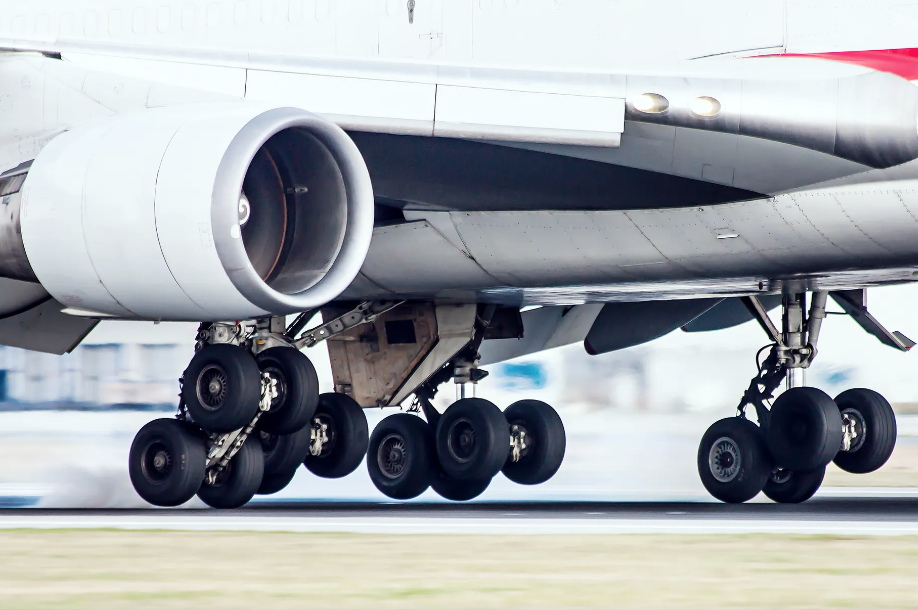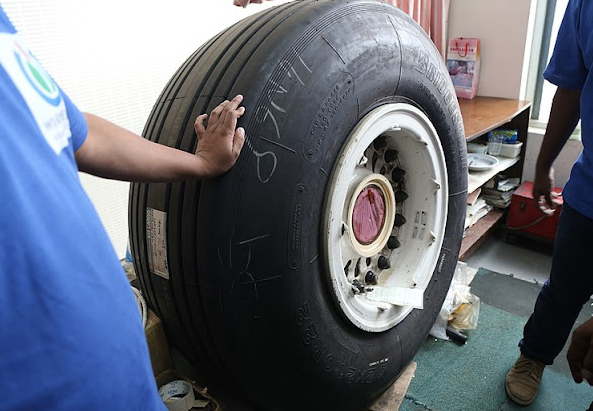

In aviation, engines, wings, and aerodynamics often steal the spotlight.
But behind every safe takeoff and smooth landing lies an essential, yet often overlooked, component-airplane tires.
These engineering marvels are a far cry from your typical car tire — designed to carry hundreds of tonnes, withstand extreme temperatures, and survive punishing landings.
Unlike regular car tires, airplane tires are made from a
sophisticated blend of materials including nylon, steel, aluminum, and
proprietary synthetic compounds.
This advanced construction allows them to endure weight of up to 300,000 kilogrammes (300 tonnes) and absorb the intense impact of landing — often at speeds exceeding 250kph.
That dramatic puff of smoke you see when a plane touches down? That’s not for show. It’s rubber literally burning from friction during impact.
Modern commercial airplanes can have between 14 and 32 wheels, each fitted with high-performance tires.
The tire-related expenses thus quickly add up, especially for large aircraft like the Airbus A380, which requires 22 tires. With a single new airplane tire costing up to US $7,000 (Sh900,000), a full replacement for such a plane can run into the hundreds of thousands of dollars.
Airplane tires look like oversized car tires but feature a complex and robust design using materials such as nylon, aluminum, steel, and proprietary synthetic compounds.
These materials provide the strength necessary to withstand extreme loads at touchdown—and the intense friction that generates the signature puff of smoke during landing.
The tires are built to tolerate wide temperature ranges, including the scorching heat produced by tread friction on runway contact.
To further ensure safety, tires are inflated with nitrogen instead of air. This is because oxygen can react under the drastic pressure and temperature changes experienced by airplane tires, sometimes causing explosions in the past.
Nitrogen, being an inert gas, remains stable under these conditions.
Airplane tires are filled to high pressures: about 200 psi for large commercial planes and as much as 320 psi for fighter jets. This is significantly higher than car tires, which usually run between 30 and 40 psi, emphasizing the tires' need to perform under intense stress.
The lifespan of an aircraft tire is typically between 200 to 400 landings.
According to Simple Flying, a leading aviation news site, this translates to roughly six months of flights but can vary widely due to factors like aircraft type, usage (passenger or cargo), flight routes, and airport environments. Some tires may last as little as 120 landings or go up to 400 landings.
Before being disposed of, airplane tires undergo retreading—a process of replacing the worn tread to extend the tire's life. Tires can generally be retreaded between eight and ten times, with each retread costing about one-fourth of a new tire's price.
“Aircraft tires can typically be retreaded up to 7 times, after which they are recycled,” SlashGear noted.
SlashGear contends that retreading process is vital for airlines to manage operating costs because replacing tires outright every time would be extremely expensive.
Replacing airplane tires is a complex, highly regulated job performed by certified technicians rather than casual mechanics.
The process begins with lifting the aircraft using specialized jacks. The wheel and brake assembly is then removed, and the tire deflated to release pressure safely.
Using specialised tools, technicians unseat the old tire and tube and remove them carefully.
Installation of a new tire involves mounting it onto the wheel halves, inserting a tube aligned with the valve stem, and tightening the assembly with a torque wrench to manufacturer-specified values.
The wheel assembly is then reinstalled onto the aircraft. Precision is critical throughout to ensure tire safety and aircraft reliability.
Several world-renowned manufacturers specialise in airplane tires. Michelin, Bridgestone, Goodyear, Dunlop, and Qingdao Sentury lead the market with advanced products designed for aviation environments.
Michelin produces around 200 million tires annually, though the majority serve the automotive industry.
They supply tires directly to aircraft manufacturers like Boeing and Airbus, as well as airlines such as Emirates and Delta. Michelin's expertise supports its reputation as a key player in the aviation tire market.
Bridgestone operates 130 factories worldwide, including a dedicated plant in North Carolina producing airplane tires.
Its products are used on popular aircraft models such as the Boeing 747 and Airbus A320. In recent years, Bridgestone has competed vigorously with Michelin for the title of the world’s largest tire manufacturer.
Aircraft manufacturers typically prefer to source specialized components like tires from established third-party vendors.
SlashGear explained: “Much like automobile manufacturers, airplane makers prefer using third-party vendors that specialise in certain components like tires rather than developing in-house solutions.”
This allows aircraft producers to focus on core aerospace technologies while leaving tire development to experts.
Given the retreading possibilities, airlines can reduce overall costs significantly by reusing tires multiple times, which is crucial for managing maintenance budgets effectively.

According to Simple Flying, a prominent online publication and the world's largest aviation news site, the tire of a commercial aircraft can perform between 200 and 300 landings, translating into approximately six months' worth of flights.
“However, it is essential to highlight that these figures vary greatly depending on the type of aircraft flown, passenger or cargo, the model, the routes flown, and the environmental conditions of the airports it flies to,” Simple Flying said.
“Therefore, to be even more precise, the lifecycle of an aircraft tire could be comprised of between 120 and 400 landings,” Simple Flying added.
Airplane tires represent a vital intersection of engineering, safety, and cost efficiency in aviation.
Their design and maintenance ensure that planes can handle the tremendous forces of flight and landing safely, while technologies like nitrogen inflation and retreading extend their service life.













